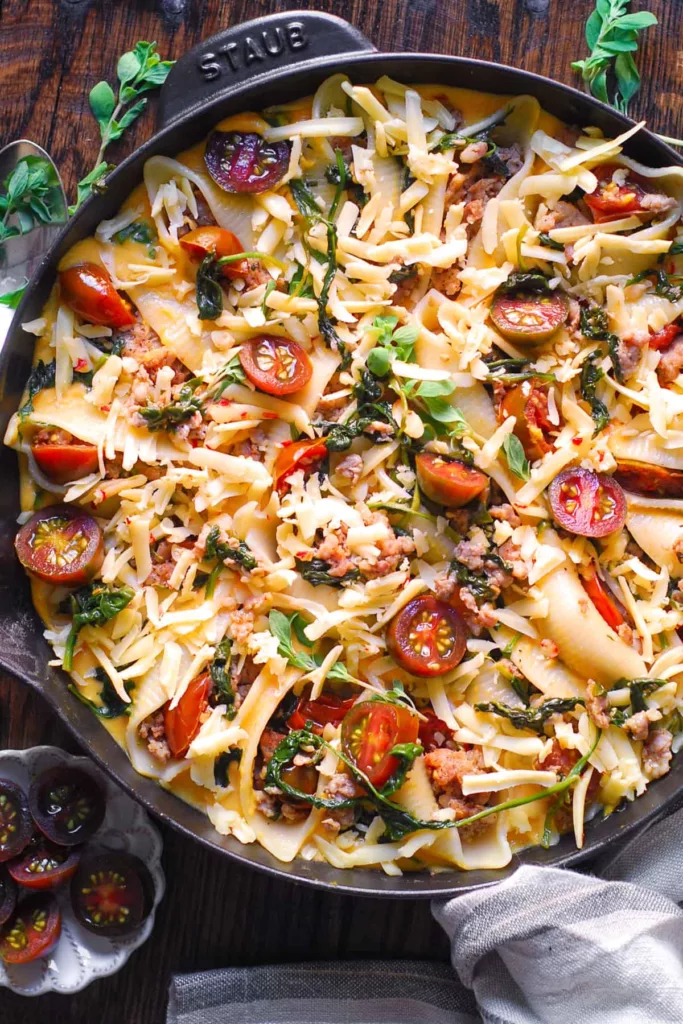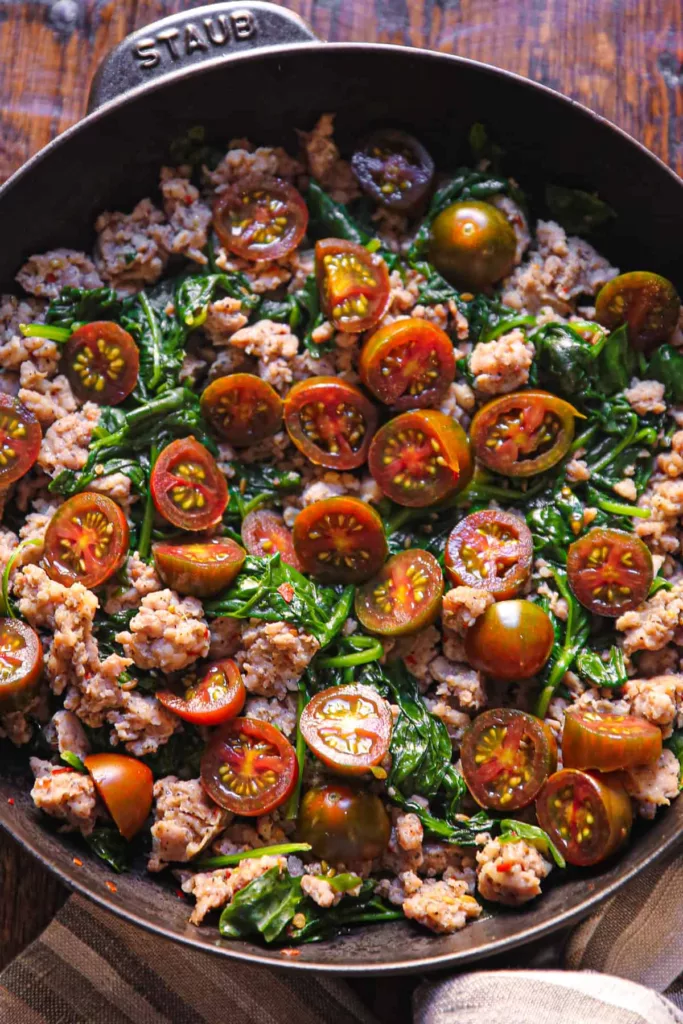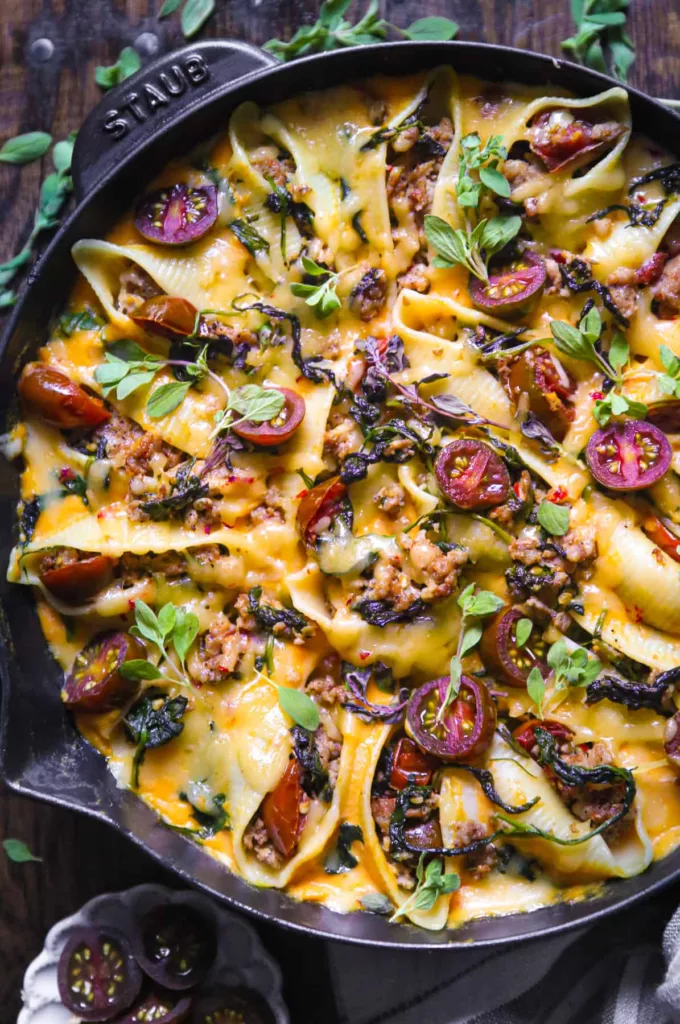The ideal Autumn/Winter comfort dish is creamy butternut squash stuffed pasta shells with sausage, spinach, and tomatoes. This pasta meal with Italian influences will add vibrant colors, fresh vegetables, and seasonal flavors to your dinner table! It is loaded with fiber, vegetables, and protein. Simple enough to prepare on a hectic evening yet elegant enough to impress visitors!

comfort food
This year’s favorite Fall supper for my family is butternut squash filled shells. And that’s not at all unexpected! When the nights are chilly and you want creamy comfort food and nutritious ingredients mixed in one dish, this pasta meal is ideal to create! Although this pasta is undoubtedly warm and comforting, it is also rich in fiber and nutrients from the tomatoes, spinach, and squash.

What makes this dish successful
- a finished dinner. Because it is a well-balanced meal with everything to keep you satisfied—protein (sausage), veggies (butternut squash, spinach, and tomatoes), carbohydrates (pasta shells), and comfort food aspect (creamy sauce and cheese)—my friends and family were raving about it.
- ideal for dinner preparation. You may prepare this dish ahead of time, store it in the fridge, and then reheat it when you need it (within three days). See down for further information.
- Fantastic presentation. Even though making butternut squash filled pasta shells on a hectic weekday is doable, you can meal prep this dish up to three days in advance and serve it to guests since it makes such a beautiful display. By meal preparing this a few days in advance, you may avoid cooking while you have people around and instead focus on enjoying friends and family.

How to make
- Prior to making the filling, prepare the pasta shells by heating the sausage, spinach, and tomatoes.
- After that, combine heavy cream and butternut squash puree to create the creamy sauce.
- The huge cooked pasta shells will then be stuffed with cooked sausage, cooked spinach, and tomatoes.
- Then, in a large oven-safe, high-sided pan, arrange the packed pasta shells on top of the creamy butternut squash sauce.
- Shredded pepper jack cheese should be sprinkled on top, then baked in the oven until the cheese melts. I’m done now! Very simple and delicious.
- Cooking advice: To make this dish even faster, make the butternut squash puree a day or two ahead of time or use canned pumpkin puree from the store.
variations
- Pumpkin puree can be used in place of butternut squash puree. In fact, if you don’t have time to roast the squash, that can be a time-saving choice. Simply substitute canned pumpkin puree for butternut squash by purchasing it.
- Greens. With this recipe, you may experiment and utilize a variety of greens. All three spinach, arugula, and kale are excellent choices.
- Sausage. I used spicy Italian sausage that was crushed. Use mild or sweet versions as well. By removing the casings first and then cooking the sausage, you may utilize it in links. The best option would be chicken sausage.
- Cheese. The butternut squash-stuffed shells taste fantastic and get a kick of heat from the pepper jack cheese. I also propose Asiago, Parmesan, or Gruyere as additional tasty cheeses.
- Butternut squash puree can be swapped out for pumpkin puree. In fact, that may be a time-saving option if you don’t have time to roast the squash. Butternut squash may be replaced with canned pumpkin puree simply by purchasing it.
- Greens. You may experiment and use a variety of greens with this recipe. Kale, spinach, and arugula are all fantastic options.
- Make it dairy-free by using vegan cheese for pepper jack cheese and unsweetened coconut milk for heavy cream.
- Tomatoes. You may use ordinary tomatoes in place of the cherry tomatoes I used.
- Garnish. Add fresh mozzarella, red pepper flakes, and herbs (such oregano or thyme) to the pasta shells as garnishes.

Cooking tips
- Use a big, heavy-bottomed, oven-safe skillet with high sides and a 12-inch cast-iron or 12-inch stainless-steel pan.
- Butternut squash puree may be made up to 4 days ahead of time. This can help you save a ton of time when preparing the dish. Alternately, you may use canned, store-bought pumpkin puree.
- Al dente pasta shells are cooked. The texture of the spaghetti is ideal at that time. It’s crucial if you want to do something ahead of schedule.
Storage and reheating tips
- Refrigerate. Shells packed with leftover butternut squash may be kept in the fridge for up to four days if they are sealed tightly.
- Freeze. This meal may be frozen for up to two months when stored in an airtight container.
- Reheat. In a large high-sided pan set over medium heat, slowly reheat the pasta, tossing once halfway through. To thin the sauce, increase the amount of milk or heavy cream.
- Things to think about. Remember that the cream sauce thickens and loses its texture when refrigerated. The sauce should be thinned slightly by adding more milk or heavy cream when reheating it the next day over medium heat.
Can you get there first?
- The entire meal may be put together in an oven-safe big pan, covered with the lid, refrigerated, and baked within three days. This recipe is excellent for supper preparation because all the components are already prepared.
- Making the butternut squash puree up to 3 days ahead of time and continuing with the recipe’s rest when you’re ready is an additional alternative.
- Pro-tip. If you want to prepare this ahead of time, cook the pasta shells until they are al dente so it will keep better in the fridge.

Other recipes
- CILANTRO LIME CHICKEN
- Savory Beef and Vegetable Delight
- HEALTHY FRENCH TOAST
- Mediterranean Naan Bread Pizza
Ingredients
- 10 oz jumbo pasta shells
- 15 oz spicy Italian sausage crumbled
- ½ teaspoon Italian seasoning
- ¼ teaspoon red pepper flakes
- 5 oz fresh spinach
- 8 oz cherry tomatoes sliced in half
- 1.5 cups butternut squash puree or use pumpkin puree
- 1 cup heavy cream
- fresh thyme
- ⅓ cup pepper jack cheese shredded
Instructions
Butternut squash puree
- Note: This recipe assumes that you have already premade butternut squash puree in advance.
Cook pasta
- Bring a large pot of water to a boil. Add pasta shells and cook according to package instructions (usually 10 or 15 minutes). Drain. In the meantime, proceed with the recipe below.
Make sausage filling
- Heat 1 tablespoon of olive oil on medium heat in a large oven-safe, heavy-bottomed, high-sided skillet. Add crumbled sausage and cook on medium heat for about 5 minutes or until the sausage is cooked. Drain excess fat.
- To the same skillet with cooked sausage, add Italian seasoning, red pepper flakes, fresh spinach, and chopped fresh tomatoes (reserve some tomatoes for later use). Cook on medium heat, stirring frequently, for 4 or 5 minutes until the spinach wilts to your liking.
- Remove the sausage and veggie mixture to a large bowl.
Make creamy butternut squash sauce
- To the same, now empty, skillet, add 1.5 cups of butternut squash puree, 1 cup of heavy cream, and a small amount of fresh thyme over medium heat and stir to combine until the sauce reaches an even consistency. Remove from heat.
Stuff pasta shells and assembly
- Preheat oven to 400 F.
- After the pasta shells are cooked and drained, start stuffing each shell with a spoonful of sausage, spinach, and tomato mixture.
- If you have remaining stuffing – mix it with the creamy butternut squash sauce in the skillet.
- Place each stuffed shell in a circular pattern on top of the creamy butternut squash sauce in a skillet.
- Top the shells with shredded Pepper Jack cheese and the remaining chopped cherry tomatoes.
- Place the skillet in the oven, uncovered, and bake in the preheated oven at 400 F for about 10 or 15 minutes to warm up the stuffed shells and melt the cheese.
Notes
- The total cooking time does not include the time required for roasting the butternut squash and making the butternut squash puree. I recommend that you do that in advance.
- Because you will be roasting whole butternut squash, you will have more than you need (1 cup) for this recipe. Refrigerate or freeze the leftover butternut squash puree in an airtight container.
- If using dried thyme instead of fresh thyme, use ½ teaspoon of dried thyme (not powdered) or ¼ teaspoon of powdered dried thyme.
